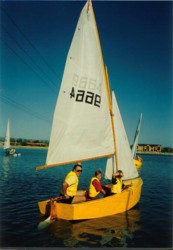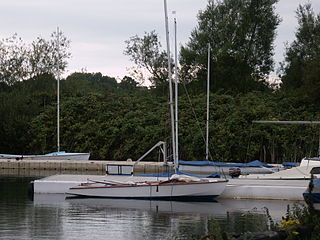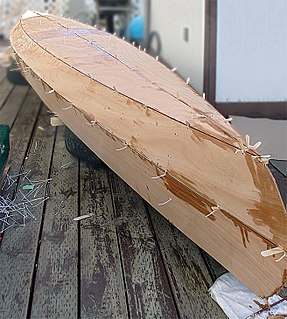
Dinghy sailing is the activity of sailing small boats by using five essential controls:
The Mirror is a popular sailing dinghy with more than 70,000 built.

The Heron Dinghy is a dinghy designed by Jack Holt of the United Kingdom as the Yachting World Cartopper. The Heron dinghy was designed to be built by a home handyman out of marine ply over a timber frame, but can now also be constructed from marine ply using a stitch and glue technique or from Fibreglass. Modern dinghies will usually have built in buoyancy tanks, older craft will have bags or retrofitted tanks.

The GP14 is a popular sailing dinghy, with well over 14,000 built.

The Wayfarer is a wooden or fibreglass hulled fractional Bermuda rigged sailing dinghy of great versatility; used for short 'day boat' trips, longer cruises and for racing. Over 11,000 have been produced as of 2016.

The Hobie Cat is a small sailing catamaran manufactured by the Hobie Cat Company.
Hobie's line of products ranges from surfboards to catamaran sailboats to kayaks and stand-up paddle boards, though the Hobie Cat Company is most famous around the world for its catamarans. Hobie also designed a very successful monohull, the Hobie 33.
The Comet dinghy is a 16-foot-long (4.9 m), two-person, one-design class, racing sloop.

Otter is a classification referring to a particular design for a two-man sailing dinghy with a glass fibre hull. Its rig consists of a main, a jib and an optional symmetric spinnaker. The hull dimensions are 11 ft 11 in length and 4 ft 10 in beam. The boat has a draft of 3 ft 6 in with the centreboard down. The sail area is 75 sq. ft. The class symbol is a stylised glass bubble; due to the original lightweight "cigar box cedar" construction of the prototypes, the name 'Bubble' was first used for the boat. John Baker obtained the plans for an expanded version of the boat in G.R.P. and hence renamed the boat 'Glass Bubble'. After being put into production by Baker, the name 'Otter' was adopted; coming from the river of the same name in East Devon, close to where the boat was manufactured.

The Cherub is a 12 feet long, high performance, two-person, Planing dinghy first designed in 1951 in New Zealand by John Spencer. The class is a development class, allowing for significant variation in design between different boats within the rule framework. The minimum hull weight was originally 110 lbs.
The Bell Woodworking Seagull and Seamew are both small sloop-rigged marine ply sailing boats of the Trailer yacht type designed by Ian Proctor, who was also responsible for the design of many small sailing dinghies in seven different classes including the extremely popular Topper, and Wanderer.

The CL 16 is a Canadian-designed 16' sloop sailboat, designed by Henry Croce and Ken Lofthouse in 1967-68 in Mahone Bay, NS. It is essentially the same design as the Wayfarer dinghy, with the addition of a double-hull and a more comfortable cockpit for recreational users. It was produced in Mahone Bay until 1970 when production was moved to the Toronto area. It continues to be produced by a Canadian company in Fort Erie, on Lake Erie, which began production in 1993 after being produced in Pickering ON since 1970.
Now in 2018, CL BoatWorks was purchased by Velocity BoatWorks and all CL production has been moved to Belleville, Ontario on the Bay of Quinte.
The Miracle is a small dinghy sailboat popularized in the United Kingdom, and designed by Jack Holt — one of the last for the well-known designer. Holt brought sailing to the masses in the 1960s with his famous Mirror dinghy, and continued to produce designs such as the Enterprise, GP14, Cadet, Hornet, Pacer, Solo, and Streaker — many of which went on to become hugely successful dinghy classes.

The Hornet dinghy is a 16 foot high performance dinghy designed by Jack Holt in 1952.

There are three designs of Phantom sailboats, one is a small una rig which is often raced, another is a lateen rig that was designed after the Sunfish model sailing dinghy, and a third is a larger keelboat designed and built in Sydney, Australia.

The 125 is a 12 ft 6 in (3.81 m) two person intermediate sailing dinghy complete with main, jib, spinnaker and trapeze. The 125 class has a strong following within Australia with national titles being held every year around the country and local state associations. The class was originally designed as an intermediate class for developing skills with the jib, spinnaker and trapeze but has become popular from novice to experienced sailors.

The Skua Sailing Dinghy is a keel assisted two-person racing sailboat, broadly similar to the Flying Fifteen in layout and planned use. It was however designed for simple and inexpensive home construction from 6mm Marine plywood.
In the 1950s, together with a variety of designs of dinghies, Fairey Marine Ltd produced larger sailing cruisers, the Atalanta, Titania, and Fulmar, also the 27' Fisherman motor sailer. They also made the 15' Cinderella / Carefree, and the 16'6" Faun.

The Laser 28 is a Canadian-built sailboat, that was designed by New Zealander Bruce Farr and first produced in 1984.
Catalac is a defunct English maritime construction company that specialised in building sailing catamarans. The company was founded by Tom Lack, in Christchurch, Dorset. After a successful period of production, the company closed in 1986. In the 1990s, the Catalac 9M was briefly revived and updated in the US as the "Catalac 900".














